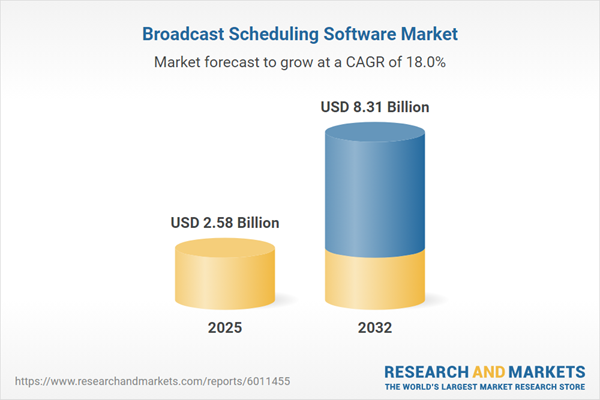Speak directly to the analyst to clarify any post sales queries you may have.
Broadcast scheduling software is reshaping how media organizations address growing content complexity, supporting coordinated workflows across linear and on-demand platforms. The increasing need for operational efficiency, automated scheduling, and enhanced viewer experiences drives adoption among broadcasters, streaming services, and content operators navigating a highly dynamic media environment.
Market Snapshot: Broadcast Scheduling Software Market Outlook
The broadcast scheduling software market grew from USD 2.20 billion in 2024 to USD 2.58 billion in 2025, with an expected CAGR of 18.03% and projected to reach USD 8.31 billion by 2032. This sector benefits from media companies seeking solutions that balance multi-channel distribution, regulatory compliance, and revenue optimization. Technological advances and evolving audience behavior are rapidly transforming operational models and creating new revenue pathways for vendors worldwide.
Scope & Segmentation of the Broadcast Scheduling Software Market
This research provides actionable insight into the full spectrum of broadcast scheduling software, examining drivers, solutions, deployment models, and user needs across key geographies and sub-segments:
- Solution: Managed Services, Professional Services, Linear Broadcast Scheduling Software, Non-Linear Scheduling Software
- Platform Type: Digital Streaming & OTT Platforms, Podcast & Audio Platforms, Radio Broadcasting, Television Broadcasting
- Content Type: Entertainment Shows, News & Journalism, Sports & Events
- Deployment: Hybrid Cloud, Private Cloud, Public Cloud, On-Premises
- Organization Size: Large Enterprises, Small & Medium-sized Enterprises (SMEs)
- Application: Ad Slot Auctions, Commercial Break Scheduling, Content Partnerships, License Management, Program Scheduling, Rights Management
- End-User: Advertising Agencies, Cable Networks, Radio Stations, Streaming & OTT Platforms
- Regions: North America (United States, Canada, Mexico), Latin America (Brazil, Argentina, Chile, Colombia, Peru), Europe (United Kingdom, Germany, France, Russia, Italy, Spain, Netherlands, Sweden, Poland, Switzerland), Middle East (United Arab Emirates, Saudi Arabia, Qatar, Turkey, Israel), Africa (South Africa, Nigeria, Egypt, Kenya), Asia-Pacific (China, India, Japan, Australia, South Korea, Indonesia, Thailand, Malaysia, Singapore, Taiwan)
- Companies Profiled: Advanced Broadcast Services Limited, Amagi Media Labs Private Limited, Axel Technology Srl, BroadView Software Inc., Caliope Media Software, Chetu, Inc., Chyro, Imagine Communications Corp., Marketron Broadcast Solutions, LLC, MediaGenix NV, mediaTool sp. z o.o., MIS, s.r.o., PROVYS, RJE Systems, Ross Video Ltd., Schedule IT Ltd., Stirlitz Media sp. z o.o., TVU Networks Corporation, Video Stream Networks S.L., WideOrbit Inc., Telefonaktiebolaget LM Ericsson, Grass Valley USA, LLC, Myers Information Systems, Inc., Aveco, Dalet S.A.
Key Takeaways for Senior Decision-Makers
- Broadcast scheduling software adoption is essential for media organizations aiming to streamline multi-channel programming and maximize advertising yield.
- The market reflects a strategic shift toward cloud-native deployments, driven by demands for agility, real-time collaboration, and modular upgrades across production teams.
- Integration of artificial intelligence and machine learning enables predictive analytics, helping operators anticipate viewer needs, automate slot allocation, and manage regulatory compliance with minimal manual input.
- Global and regional regulatory changes, especially tariffs on hardware and software, are prompting transitions to cloud solutions and local partnerships that lower exposure to cost volatility while maintaining operational flexibility.
- Vendors are building value by embedding advanced ad management tools, rights management modules, and comprehensive compliance features directly into scheduling systems to better monetize and secure content rights.
- Strategic alliances between ad tech, system integrators, and content management providers are accelerating the pace of innovation, enabling tailored solutions for broadcasters, OTT platforms, and multi-territory operations.
Tariff Impact on the Broadcast Scheduling Software Market
Recent tariff introductions in the United States are increasing hardware and software costs, impacting deployment strategies for global media companies. Organizations in response are prioritizing cloud-based deployments and fostering local service partnerships. These shifts are driving investment in automation to offset expenditure and streamline supply chains.
Methodology & Data Sources
Methodologies include in-depth interviews with senior executives, targeted surveys with technical staff, and detailed reviews of public filings and vendor literature. Triangulated analysis and scenario modeling ensure accurate, reliable market intelligence.
Why This Broadcast Scheduling Software Report Matters
- Gain a clear, actionable roadmap for selecting, implementing, and optimizing broadcast scheduling solutions as competition intensifies.
- Identify risks and opportunities stemming from technological advances, regulatory changes, and shifting consumption patterns across regional markets.
- Benchmark leading vendors and deployment practices to support investment decisions that align with organizational priorities and growth targets.
Conclusion
This report offers concise, fact-based guidance for leveraging broadcast scheduling software to drive competitive advantage. Informed strategic decisions can unlock greater efficiency, improve revenue opportunities, and future-proof content operations in a rapidly evolving media landscape.
Additional Product Information:
- Purchase of this report includes 1 year online access with quarterly updates.
- This report can be updated on request. Please contact our Customer Experience team using the Ask a Question widget on our website.
Table of Contents
3. Executive Summary
4. Market Overview
7. Cumulative Impact of Artificial Intelligence 2025
Companies Mentioned
The companies profiled in this Broadcast Scheduling Software market report include:- Advanced Broadcast Services Limited
- Amagi Media Labs Private Limited
- Axel Technology Srl
- BroadView Software Inc.
- Caliope Media Software
- Chetu, Inc.
- Chyro
- Imagine Communications Corp.
- Marketron Broadcast Solutions, LLC
- MediaGenix NV
- mediaTool sp. z o.o.
- MIS, s.r.o.
- PROVYS
- RJE Systems
- Ross Video Ltd.
- Schedule IT Ltd.
- Stirlitz Media sp. z o.o.
- TVU Networks Corporation
- Video Stream Networks S.L.
- WideOrbit Inc.
- Telefonaktiebolaget LM Ericsson
- Grass Valley USA, LLC
- Myers Information Systems, Inc.
- Aveco
- Dalet S.A.
Table Information
| Report Attribute | Details |
|---|---|
| No. of Pages | 190 |
| Published | November 2025 |
| Forecast Period | 2025 - 2032 |
| Estimated Market Value ( USD | $ 2.58 Billion |
| Forecasted Market Value ( USD | $ 8.31 Billion |
| Compound Annual Growth Rate | 18.0% |
| Regions Covered | Global |
| No. of Companies Mentioned | 26 |









